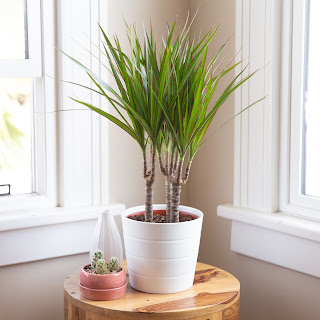These houseplants are the best place to start your collection. They are all easy to grow and can generally withstand erratic watering, uneven or bad light, and fluctuating temperatures. They will thrive in dorm rooms, offices, and sometimes even dismal corners.
Golden Pothos Vine
There is a reason golden pothos (Epipremnum pinnatum "Aureum") is one of the most popular hanging plants around. In its native habitat, golden pothos grows into a tree-swallowing monster with huge yellow and green leaves.
As a houseplant, the plant will grow aggressively from pots or trailing baskets with minimal care. They will easily root in a simple glass of water. With better care, large, mottled, mature leaves may develop.

Spider Plant
A well-grown spider plant (Chlorophytum) is a magnificent thing. The plant grows easily in baskets or atop columns with arching leaves. The variegated variety is by far the most common. Over time, a mature plant will send out plantlets or offsets on long stems that form an impressive hanging display.
These plantlets can be easily repotted to create new specimens. Spider plants are not picky about water, light, or temperature.

Snake Plant
In the same family that includes dracaena and liriope, there are many varieties of sansevieria (S. trifasciata or S. trifasciata laurentii) that are exceptionally tough. They like plenty of light, but they can handle less if necessary, and they are not too particular about watering—as long as it is not too much. They also thrive in an office environment.
When repotting is necessary, the main clump can be easily divided. These plants are striking additions to a collection. The snake plant features green on green bands on sword-like leaves, while the mother-in-law's tongue has yellow leaf margins.

Dracaena Species
There are many varieties of Dracaena suitable for home growth. The D. draco and D. marginata are wonderfully easy plants that tolerate a wide variety of conditions. These plants feature arching leaves from a woody stem.
Dracaena leaves can be green, yellow and green, or even tri-colored. Also, a member of the agave family, they like to be regularly watered in the summer and almost left dry throughout the winter. D. fragrans are often used to make popular ti plants or false palms.

Succulents and Cacti
There are dozens of varieties of succulents and desert cacti flooding into garden centers and grocery stores. In general, succulents are desert plants with thick, fleshy leaves; some of them have spines and some none. Agave is an example of a popular succulent, along with aloe and popular echeveria rosettes.
Cacti generally have spines and interesting leaf structures, including barrels, paddles, and columns. As a class, succulents and cacti are slow-growing and will withstand tremendous abuse. They do their best with bright light, well-drained pots, and a little water. In the right placement, these are plants that truly thrive on neglect.

Bromeliads
These plants have gained an unfair reputation, probably because of the difficulty required to coax a bloom from a bromeliad. It is true that making these jungle plants bloom in the house is a tricky task. They require copious warmth and water, along with high humidity and filtered light to produce their showy flower spikes.
However, many species of bromeliads have beautiful leaves that are attractive by themselves. Bromeliad plants are usually watered by filling the central cup. They require little fertilizer, and when pups appear around the base of the plant, these can be repotted to increase your collection.
Lucky Bamboo
Technically a dracaena species, lucky bamboo (Dracaena sanderiana) is the perennial office plant. Untold pots of these thrive in awful conditions, such as sporadically watered with bad lighting and poor air quality.
Nevertheless, lucky bamboo lives on. These make wonderful gift plants, and many people believe they bring good luck and enhance the chi or energy of their surroundings.










Comments
Post a Comment